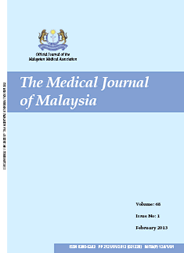MJM, Vol 70 Supplement 1 September 2015
Radionuclide leachability as a potential pathway of
radium contamination in water
*Institute for Public Health, Ministry of Health, **Malaysian Nuclear Agency, Ministry of Science, Technology and Innovation
ABSTRACT
Introduction: This survey was to study the radionuclide leachability behaviour in order to monitor and mitigate the possibility of radionuclide ingestion and uptake due to radium contamination in our water resources.
Method: Five different types of bricks; clay, cement, paver, granite and fly ash were sourced from several hardware stores in Selangor. They were used as the samples. These samples were prepared according to two different methods used; toxicity characteristic leaching procedure, TCLP method 1311 to imitate harsh environment and Monolithic leaching test in accordance with BSI EN 1744-3:2002 to study leaching behaviour of the radionuclide under natural condition. Leachates collected from both methods were measured for radioactivity by using Gamma Spectrometer.
Results: Leaching behaviour of the radionuclide in the samples through toxicity characteristic leaching procedure, TCLP shows activity concentration of Radium 226 in clay bricks is the highest; 3.35 ± 0.59 BqL-1 followed by fly ash bricks ; 3.25 ±0.55 BqL-1, granite bricks ;3.10 ± 0.57 BqL-1,cement bricks; 3.08 ± 0.55 BqL-1 and the lowest is in paver bricks ; 2.78 ± 0.56 BqL-1.Meanwhile, only two types of bricks possess activity concentration of Radium 228; paver bricks and fly ash bricks;1.10 ± 1.47 BqL-1, 0.66 ±1.42 BqL-1 respectively. For monolithic leaching test procedure, result shows that activity concentration of Radium 226, detected throughout 30 days of analysis is from 5.00 BqL-1 to 0.64 BqL-1 and from 0.1 to 7.32 BqL-1 for activity concentration of Radium 228.In clay, granite and paver brick, the activity concentration of Ra-228 can be detected throughout the 30 days while for the other brick, the activity concentration of the Ra-228 can only be detected after seven days of immersion.
Conclusion: The study revealed leachability of radium occurring under both conditions; natural and harsh..
Keywords: brick, naturally occurring radioactive material, radionuclide leachability and radium
